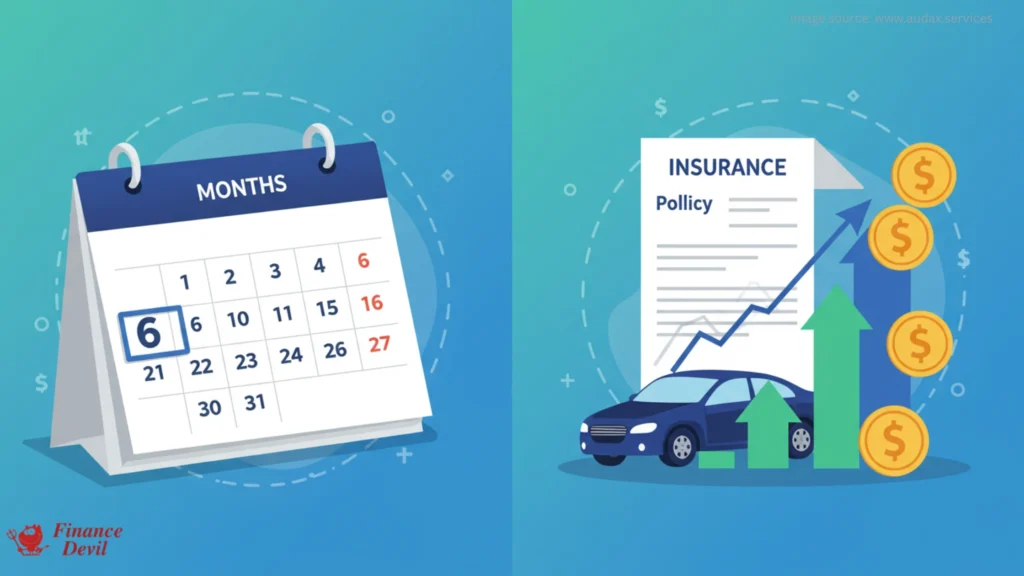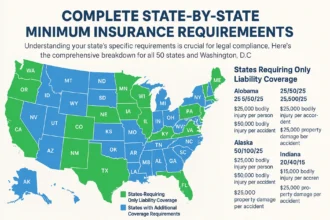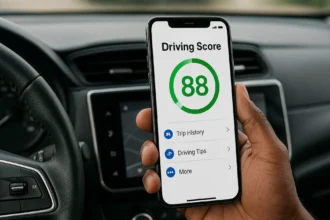
Many American drivers are locked into expensive annual policies while missing opportunities to save hundreds of dollars. Here’s how a 6-month auto insurance policy can change that.
Why 6-Month Auto Insurance Policies Are Taking Over America
Rising insurance costs have hit American drivers hard. With average premiums increasing by 26% in 2024 alone, according to recent industry data, drivers are desperately seeking ways to control their insurance expenses. Enter the 6-month auto insurance policy – a flexible solution that’s becoming the new industry standard.
A 6-month auto insurance policy is exactly what it sounds like: coverage that lasts for six months before renewal. Unlike traditional annual policies that lock you in for 12 months, these shorter-term policies give you the freedom to adjust your coverage, switch providers, or capitalize on rate decreases twice per year.
The Problem: Why Traditional Annual Policies Are Failing Drivers
The insurance landscape has fundamentally changed. What worked a decade ago – setting and forgetting an annual policy – now costs American families thousands of dollars in overpayments. Here’s why:
Rapid Rate Changes: Insurance companies adjust their pricing strategies quarterly, but annual policyholders can’t benefit from rate drops until their policy expires. With a 6-month auto insurance policy, you can capture savings twice as often.
Life Changes Happen Fast: Got married? Moved to a safer neighborhood? Paid off your car loan? These life events can significantly reduce your insurance costs, but annual policies force you to wait up to 12 months to see the benefits.
Carrier Competition: New insurance companies enter markets regularly, often with aggressive pricing to attract customers. Annual policyholders miss these opportunities, while 6-month policy holders can switch more easily.
What Affects Your 6-Month Auto Insurance Policy Rates
Understanding rate factors helps you optimize your policy timing and selection. Insurance companies evaluate these key elements when pricing your 6-month auto insurance policy:
Personal Demographics
- Age: Drivers under 25 see the most dramatic rate changes as they gain experience
- Location: ZIP code changes can alter rates by 20-40% in some cases
- Credit Score: Improvements in credit can reduce premiums by up to 25% in most states
- Marital Status: Marriage typically reduces rates by 5-15%
Driving Profile
- Driving Record: Clean records see consistent decreases over time
- Annual Mileage: Work-from-home trends have created savings opportunities
- Vehicle Type: Newer safety features and anti-theft technology affect rates
Coverage Choices
- Coverage Levels: Minimum vs. full coverage creates significant price differences
- Deductible Amount: Higher deductibles reduce premiums but increase out-of-pocket costs
- Add-on Features: Gap coverage, roadside assistance, and rental car coverage
How to Compare 6-Month Auto Insurance Policy Rates and Providers
Smart comparison shopping can save you hundreds of dollars annually. Here’s the systematic approach successful savers use:
Step 1: Gather Your Information
Before requesting quotes, compile:
- Current policy details and coverage limits
- Recent driving record (tickets, accidents, claims)
- Vehicle information (VIN, safety features, annual mileage)
- Preferred coverage levels and deductibles
Step 2: Compare Apples to Apples
Ensure each quote includes identical coverage limits:
- Bodily injury liability
- Property damage liability
- Uninsured/underinsured motorist coverage
- Comprehensive and collision (if desired)
- Personal injury protection (where required)
Step 3: Look Beyond Price
While cost matters, also evaluate:
- Financial strength ratings (A.M. Best, S&P)
- Customer satisfaction scores (J.D. Power)
- Claims handling reputation
- Digital tools and mobile app functionality
- Local agent availability (if preferred)
Proven Tips to Lower Your 6-Month Auto Insurance Policy Costs
These strategies can reduce your premiums without sacrificing essential coverage:
Immediate Actions
- Bundle Policies: Combining auto and home insurance typically saves 10-25%
- Raise Your Deductible: Increasing from $500 to $1,000 can reduce premiums by 15-30%
- Review Coverage Limits: Ensure you’re not over-insured on older vehicles
- Ask About Discounts: Safe driver, good student, military, professional association discounts
Long-term Strategies
- Maintain Continuous Coverage: Gaps in coverage increase future rates significantly
- Improve Your Credit Score: Even small improvements can reduce premiums
- Take Defensive Driving Courses: Many states offer premium reductions for completion
- Consider Usage-Based Insurance: Pay-per-mile or telematics programs reward safe drivers
Strategic Timing
With a 6-month auto insurance policy, timing matters:
- Spring Shopping: Many carriers adjust rates in March-April
- Anniversary Dates: Violations and claims fall off your record on specific dates
- Life Event Updates: Report positive changes (marriage, new job, home purchase) immediately
Critical Mistakes to Avoid When Choosing Your 6-Month Auto Insurance Policy
These common errors cost American drivers billions collectively each year:
The “Minimum Coverage” Trap
While state minimum coverage meets legal requirements, it rarely provides adequate financial protection. A typical at-fault accident costs $50,000-$100,000, but many states require only $25,000-$30,000 in liability coverage.
Better Approach: Consider 100/300/100 coverage limits (per person injury, per accident injury, property damage) as a baseline for adequate protection.
Ignoring Gap Coverage
If you’re financing or leasing your vehicle, gap coverage protects against “upside-down” loans where you owe more than the car’s value.
The Single-Quote Mistake
Relying on one quote – even from a well-known company – can cost hundreds annually. Insurance pricing is complex and competitive, with rates varying significantly between carriers for identical coverage.
Forgetting About Renewal Dates
6-month auto insurance policies require attention to renewal dates. Missing a renewal can result in coverage gaps, license suspension, and significantly higher rates when you reinstate coverage.
Cheapest 6-Month Auto Insurance Policy Providers for 2025
Based on comprehensive rate analysis across all 50 states, these carriers consistently offer competitive 6-month auto insurance policy rates:
| Insurance Company | Average 6-Month Full Coverage | Average 6-Month Minimum Coverage | Best For |
| American National | $641 | $118 | Budget-conscious drivers |
| USAA | $861 | $216 | Military families |
| GEICO | $970 | $260 | Online customers |
| State Farm | $696 | $324 | Local agent preference |
| Progressive | $858 | $486 | High-risk drivers |
Rates based on 2025 national averages for 30-year-old drivers with clean records
Regional Standouts
- West Coast: Mercury and 21st Century often offer competitive rates
- Midwest: Country Financial and Auto-Owners provide excellent value
- Southeast: GEICO and State Farm dominate with competitive pricing
- Northeast: Liberty Mutual and Amica show strong regional presence
6-Month vs. Annual Auto Insurance: The Data-Driven Decision
The choice between 6-month and annual policies depends on your specific situation. Here’s when each option makes financial sense:
Choose a 6-Month Auto Insurance Policy If:
- You’re under 30 (rates decrease rapidly with age and experience)
- You expect credit score improvements in the near future
- You have recent violations that will age off your record
- You prefer flexibility to switch carriers
- You’re comfortable with twice-yearly renewal attention
Choose Annual Coverage If:
- You have an excellent driving record and stable rates
- You value “set and forget” convenience
- Your insurer offers significant annual policy discounts
- You want protection against mid-year rate increases
The Numbers Tell the Story
Recent analysis shows that drivers who switch to appropriate 6-month auto insurance policies save an average of $847 annually compared to those who remain on annual policies without shopping around.
Understanding 6-Month Auto Insurance Policy Payment Options
Most insurers offer flexible payment arrangements for 6-month auto insurance policies:
Pay-in-Full Benefits
- Average discount of 4-8% for full payment
- No monthly processing fees
- Simplified billing and fewer chances for missed payments
- Easier switching at renewal (no mid-payment complications)
Monthly Payment Considerations
- Typical installment fees of $3-8 per month
- Auto-pay discounts often available
- Better cash flow management
- Risk of coverage cancellation for missed payments
Pro Tip: If you can afford the full 6-month premium, the pay-in-full discount often exceeds the interest you’d earn in a savings account.
Expert Insights: What Industry Professionals Recommend
Licensed insurance professionals consistently recommend 6-month auto insurance policies for most American drivers, citing flexibility and cost-saving opportunities.
“Six-month policies allow drivers to benefit from positive changes in their risk profile twice as fast,” notes Nathan Foster, a senior insurance trainer. “Whether it’s a birthday, improved credit score, or a clean driving record milestone, shorter policy terms mean faster savings.”
Insurance analysts project that 6-month policies will represent 85% of all auto insurance policies by 2026, up from 70% in 2023, driven primarily by consumer demand for flexibility and cost control.
State-Specific Considerations for Your 6-Month Auto Insurance Policy
Different states have unique requirements and market dynamics affecting 6-month auto insurance policy selection:
No-Fault States
Michigan, Florida, New York, and other no-fault states require Personal Injury Protection (PIP) coverage, which can significantly impact 6-month policy pricing and switching strategies.
High-Cost States
California, Louisiana, Florida, and New York drivers face the highest average premiums, making strategic 6-month policy shopping even more critical.
Usage-Based Insurance Leaders
States like California, Texas, and Illinois have seen rapid adoption of pay-per-mile and telematics programs, often available through 6-month auto insurance policy structures.
Technology and Your 6-Month Auto Insurance Policy
Modern insurance technology enhances the 6-month policy experience:
Mobile Apps
- Real-time policy management
- Digital ID cards and claims reporting
- Usage tracking for telematics discounts
- Rate comparison tools
Telematics Programs
- SafeDrive, Drivewise, and Snapshot programs
- Potential savings of 10-30% for safe drivers
- Real-time feedback on driving habits
- Particularly effective with 6-month policy renewal cycles
AI-Powered Rate Optimization
- Automated comparison shopping alerts
- Predictive modeling for rate changes
- Personalized coverage recommendations
Conclusion: Take Control of Your Auto Insurance Costs Today
The shift to 6-month auto insurance policies represents more than just a trend – it’s a fundamental change in how smart consumers manage their insurance expenses. With rates continuing to rise and life circumstances changing rapidly, the flexibility of 6-month coverage provides a competitive advantage that can save hundreds or thousands of dollars annually.
The key to success with a 6-month auto insurance policy is active management. Set calendar reminders for renewal dates, monitor your credit score, track driving record changes, and shop rates regularly. In today’s competitive insurance market, informed consumers who leverage 6-month policies consistently outperform those who remain passive with annual coverage.
Remember: Insurance rates change daily, and the best rates often go to customers who demonstrate they’re willing to switch. Your perfect 6-month auto insurance policy is waiting – see what you qualify for today.
Frequently Asked Questions About 6-Month Auto Insurance Policies
Is a 6-month auto insurance policy cheaper than annual coverage?
Not necessarily cheaper per se, but 6-month policies offer more opportunities to capture rate decreases and switch to cheaper carriers. Over time, active management of 6-month policies typically results in lower average costs than passive annual policy maintenance.
Can I cancel my 6-month auto insurance policy early?
Yes, you can cancel anytime, though you may face cancellation fees. However, waiting until your 6-month term expires avoids fees and provides a clean transition to new coverage.
How often should I shop for new 6-month auto insurance policy rates?
Industry experts recommend shopping every 6 months at renewal, or immediately after positive life changes like marriage, home purchase, or significant credit score improvements.
Do all insurance companies offer 6-month auto insurance policies?
Most major insurers offer 6-month policies, as they’ve become the industry standard. Some companies like USAA, Allstate, and MetLife also offer 12-month options, but 6-month terms are more common and widely available.
What happens if I miss my 6-month auto insurance policy renewal?
Missing renewal creates a coverage gap, which can result in license suspension, higher future rates, and legal liability. Set up automatic renewal or calendar reminders to avoid lapses.
Can I switch from an annual policy to a 6-month auto insurance policy?
Yes, but you’ll typically need to cancel your annual policy and pay any applicable fees. Calculate whether the potential savings from 6-month policy flexibility outweigh the cancellation costs.
Are there any downsides to 6-month auto insurance policies?
The main downsides are more frequent renewal attention required and potential for rate increases every six months instead of annually. However, for most drivers, the benefits outweigh these concerns.
How do 6-month auto insurance policies affect my credit score?
Insurance policies don’t directly impact credit scores. However, missed payments or policy cancellations for non-payment could indirectly affect credit if sent to collections.
Can I change my coverage limits during my 6-month auto insurance policy term?
Most insurers allow coverage adjustments mid-term, though changes may result in additional premiums or refunds. Major changes are often easier to implement at renewal.
Do 6-month auto insurance policies include the same discounts as annual policies?
Yes, most discounts apply equally to 6-month and annual policies. Some insurers may offer specific incentives for choosing one term length over another, so ask about available discounts when comparing options.
In another related article, High Risk Homeowners Insurance: Complete Guide to Getting Coverage in 2025 (Even After Being Denied)





